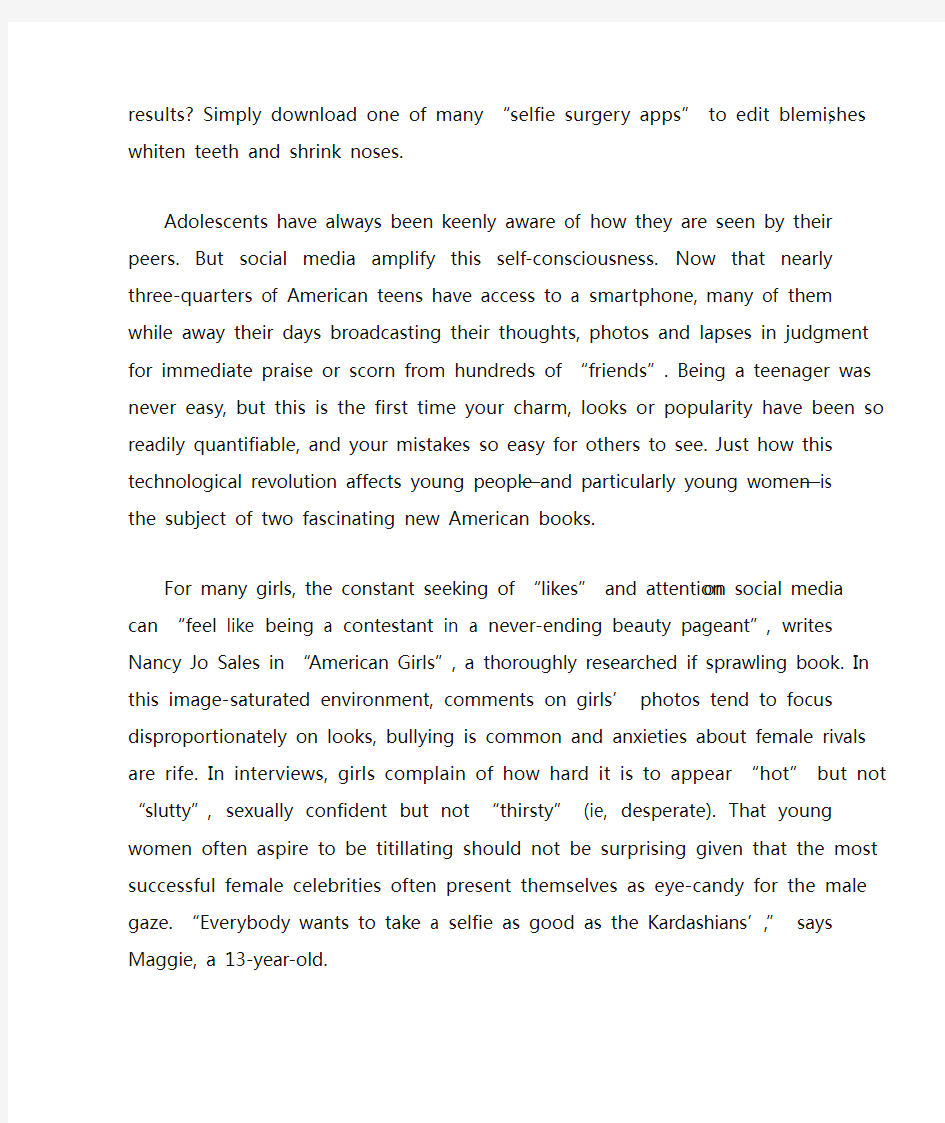

Girls and sex
Two steps forward, one back
For girls, growing up is a perilous journey
Apr 2nd 2016 | From the print edition
The uses of enchantment
American Girls: Social Media and the Secret Lives of Teenagers. By Nancy Jo Sales. Knopf; 416 pages; $26.95 and £20.
Girls & Sex: Navigating the Complicated New Landscape. By Peggy Orenstein. Harper; 320 pages; $26.99.
FOR tips on taking a selfie, talk to teenage girls. Many know that your “good” side is the one without your parting, and that it is slimming to pose with a hand on hip and legs “bevelled” (one straight, the other bent). Not quite pleased with the results? Simply download one of many “selfie surgery apps” to edit blemishes, whiten teeth and shrink noses.
Adolescents have always been keenly aware of how they are seen by their peers. But social media amplify this self-consciousness. Now that nearly three-quarters of American teens have access to a smartphone, many of them while away their days broadcasting their thoughts, photos and lapses in judgment for immediate praise or scorn from hundreds of “friends”. Being a teenager was never easy, but this is the first time your charm, looks or popularity have been so readily quantifiable, and your mistakes so easy for others to see. Just how this technological revolution affects young people—and particularly young women—is the subject of two fascinating new American books.
For many girls, the constant seeking of “likes” and attention on social media can “feel like being a contestant in a never-ending be auty pageant”, writes Nancy Jo Sales in “American Girls”, a thoroughly researched if sprawling book. In this image-saturated environment, comments on girls’ photos tend to focus disproportionately on looks, bullying is common and anxieties about female riv als are rife. In interviews, girls complain of how hard it is to appear “hot” but not “slutty”, sexually confident but not “thirsty” (ie, desperate). That young women often aspire to be titillating should not be surprising given that the most successful female celebrities often present themselves as eye-candy for the male gaze. “Everybody wants to take a selfie as good as the Kardashians’,” says Maggie, a 13-year-old.
Such self-objectification comes at a cost. A review of studies from 12 industrialised countries found that adolescent girls around the world are increasingly depressed and anxious about their weight and appearance. For Peggy Orenstein, an American journalist, these are symptoms of a larger and more pernicious problem: “the pressure on young wom en to reduce their worth to their bodies and to see those bodies as a collection of parts that exist for others’ pleasure”. In “Girls & Sex”, a wise and sharply argued look at how girls are navigating “the complicated new landscape” of sex and sexuality, M s Orenstein notes that unlike past feminists, who often protested against their sexual objectification, many of today’s young women claim to find it empowering. “There are few times that I feel more confident about my body than when I wear a crop top and m y boobs are showing and my legs are showing,” says Holly, a college student. “I never feel more liberated.”
This hardly seems like progress, particularly when only certain bodies, those that are sexy to men, are allowed to be a source of pride. (Even Megha n Trainor’s body-positive anthem, “All About That Bass”, celebrates fuller bodies because “boys, they like a little more booty to hold at night.”) Yet both authors argue that girls are embracing their own sexualisation in part because they are living in a culture that prioritises women being “hot”. Just listen to Donald Trump, America’s Republican presidential front-runner, or try to find a female news presenter wearing a dress with sleeves.
Both books also blame the “ever-broadening influence of porn”. The internet has made pornography more widely available than ever before. Few view it as realistic, but many consult it as a guide—which makes sense in a country where parents rarely talk candidly about sex with their children, especially their daughters, and few schools fill the gap. Educators commonly advocate abstinence and only 13 states require that sex education even be medically accurate.
The problem is that much of this pornography is not only explicit but also violent, which can influence expectations. A study of Canadian teenagers found a
correlation between consuming pornography and believing it is okay to hold a girl down for forced sex. Pornography also tends to present women’s sexuality as something that exists primarily for the benefit of men. Ms Orenstein notes that most of the young women she interviewed had removed all of their pubic hair since they were about 14 in order to cater to the fickle, porn-bred tastes of young men. They also tended to prioritise their partners’ physical pleasure over their own.
For anyone raising a daughter, these books do not make for easy reading. Expect plenty of stories about binge drinking, random hookups, oral sex and misjudged sexting. Intellectually, many young women believe they can achieve whatever they set their minds to, but most still struggle to obey a sexual double-standard that gives them little room between being chided as “sluts” or “prudes”. As one teenage girl tells Ms Orenstein, “Usually the opposite of a negative is a positive, but in this case it’s two negatives. So what are you supposed to do?”